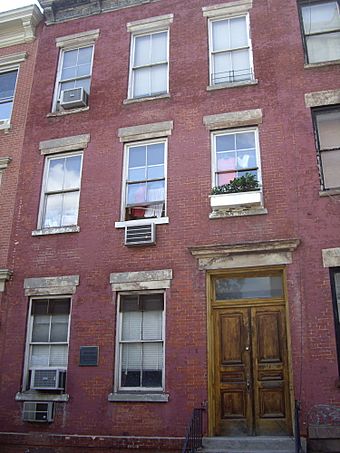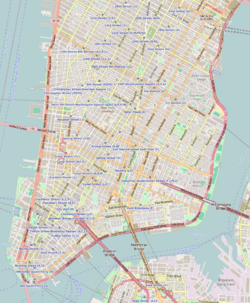Alfred E. Smith House facts for kids
|
Alfred E. Smith House
|
|
 |
|
| Location | 25 Oliver Street, Manhattan, New York City, New York |
|---|---|
| Area | 0.1 acres (0.040 ha) |
| Built | c. 1880 |
| Architectural style | Victorian |
| NRHP reference No. | 72000882 |
Quick facts for kids Significant dates |
|
| Added to NRHP | November 28, 1972 |
| Designated NHL | November 28, 1972 |
The Alfred E. Smith House is a special historic building located at 25 Oliver Street in the Two Bridges area of Lower Manhattan in New York City. This house was the home of Alfred E. Smith (1873-1944). He was a very important politician who served four times as the governor of New York State. He also ran for President in 1928.
Al Smith lived in this house from 1907 to 1923. The house was recognized as a National Historic Landmark in 1965 because of its connection to him.
About the House
The Alfred E. Smith House is a three-story brick house. It is located on the west side of Oliver Street in Lower Manhattan. You can find it across from the Alfred E. Smith Elementary School.
The house has three main sections on the front. Its roof has decorative blocks called a modillioned cornice. The main door is on the right side. Above the door, there is a small window and a decorative frame. Inside, the house still has some original features from the Victorian era. These include old tile floors and a fancy stairway post. Some changes were made when Al Smith lived there. For example, glass doors were added between the main hall and the front room. Experts believe the house was built sometime between 1870 and 1890.
Al Smith's Time in the House
Al Smith rented this house from the nearby St. James Church. He lived here from 1907 until 1923. This period was very important for him. Living here helped shape his political ideas and beliefs. These ideas helped him become the New York governor in 1919. Later, they led to his run for President in the 1928 election.
Al Smith's rise in politics was new for the country. Before him, many national leaders came from farms or small towns. Smith was different because he came from a big city. This showed a shift in American politics. However, he faced challenges in his presidential campaign. His Roman Catholic faith was a factor at the time. Also, the country was doing well after World War I. This prosperity was largely managed by Republican leaders.
After Al Smith moved out in 1923, the house had different uses. An undertaker used it until 1930. The St. James Church still owned the house. When it was named a National Historic Landmark in 1972, only one tenant lived there.
See also
 In Spanish: Casa Alfred E. Smith para niños
In Spanish: Casa Alfred E. Smith para niños




